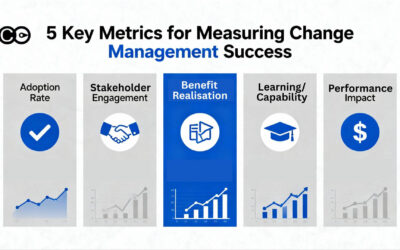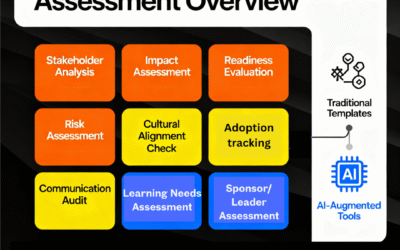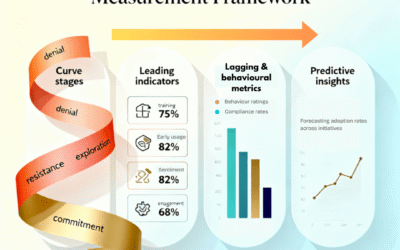What is change saturation?
Change Saturation is a concept that describes our capacity for change as limited … like a cup. We have a limited amount of capacity for change. When there is too much change going on the cup spills over and there is ‘change saturation’. When this happens with too much change then there is stress in the impacted stakeholder groups.
It could be that there is intense increase in workload or work complexity. Performance could drop as a result. When frontline staff experience change saturation it could be that they don’t have the capacity to support all the customer enquires leading to longer customer wait times. Customer satisfaction levels could be impacted. Employee satisfaction could also be impacted.
What causes it?
There are 3 causes for change saturation
1. There are too many initiatives going on at the same time. The totality of changes across multiple initiatives leads to the cup being overfilled. This is the reality of corporate life. There aren’t many organizations that are only executing one initiative at any one time. However, it also depends on the level of impact within each initiative and not just the number of initiatives in total. If every initiative has very little impact it could be smaller in total than a very large complex change initiative with very high impact. It will take a lot of peanuts to fill up a jar, versus a few large biscuits.
2. The change initiatives are occurring too fast. We have all been through highly agile initiatives that have short sprints, that pivot quickly and implement the change quickly as well. Often due to discoveries and learnings along the way there are project delays as the project figures out how to get itself on track. However, the original go-live date has not been changed so as to meet senior stakeholder expectations and to manage project cost. What this means is that the impacted business suddenly has much less time to get ready for the change compared to the original timeline. This condensed timeline to go through and embed the changes leads to increased change saturation.
3. Business circumstances have lead to the cup being overfilled. In the case of COVID19, most businesses are going through challenging times. Some are struggling to cope with increased customer volumes, whilst others have lost significant business and can no longer operate. During these times businesses revert to survival mode, or their business continuity plan. The top focus remains to delivery its core services with all other priorities to take a back seat. The very nature of this environment means that a large part of the organisation is under immense pressure to perform. The cup is saturated even before any additional planned initiatives. To read more about Planning for change during COVID19 click here.
How to measure it
Every part of the organization may have a different level of change saturation. This is because different teams play different functional roles by definition. As a result one department may be impacted by the same change differently compared to another.
Therefore it is important to be able to measure the change saturation point for a part of the business if we are aiming to manage it. Change saturation should not just be a point of discussion just based on feelings and perceptions.
How do we measure the change saturation point for one part of the business? Measuring change saturation is not purely a science but more of an art.
Take for example, you have been working closely with the call centre team and have monitored their business performance across different initiatives over the past few months. Last month you noticed that they had reached a point where there were more initiatives being implemented than previously.
On top of this you noticed that some of their performance metrics that may be linked to change saturation were negatively affected. These included increased call waiting time, decreased customer satisfaction, increased staff turnover, and challenges for planners to schedule sufficient resources to cover shifts and undergo allocated initiative activities such as training. Team leaders also provided feedback that there was too much change going on and managing workload was challenging.
You can then calculate this change saturation by assigning a weighting to each change initiative in terms of its change impacts on the business. Then adding the various change impacts for last month will give you a total factor of change saturation. Last month your assessment, together with the call centre business, is that there was definite change saturation. So, if you see this level of change approaching in your planning coming up, then this would be a red signal for you to start to work with your stakeholders on managing this upcoming Change saturation.
Here is an example of measuring change saturation with The Change Compass.
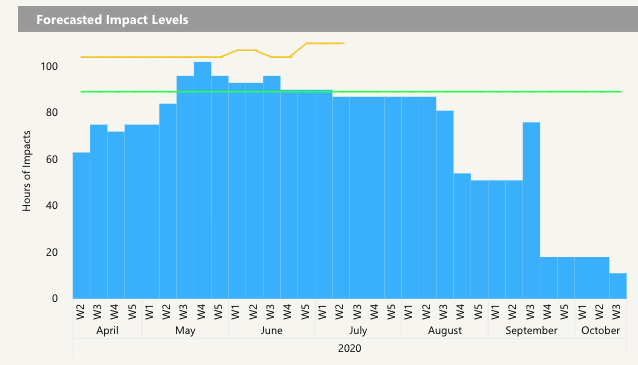
It is important to note that some businesses may be calling out that they have change saturation simply to lower the expectation bar. By lowering the bar expected to undergo change volume, it is then easier for them to meet their performance targets. This is why it is important to measure change saturation. Anyone can claim that their cup is overflowing with change without data to support.
How to manage it
There are 2 main ways to manage change saturation. Either you reduce the change saturation level or you increase the change capacity (increasing the size of the cup).
Short term – Reduce change saturation
1. Stop all change initiative roll out during COVID19. If your organization is undergoing significant challenges and it was deemed that the cup is already overflowing in terms of capacity, then work with your business to determine how long of a period would there need to be a hold of any change implementation. This decision may be reviewed on a monthly basis or fortnightly basis to enable careful monitoring of the development COVID19 impact on the organisation.
2. Delay the roll-out of change initiatives to reduce change saturation. Work with your stakeholders to re-prioritise certain initiatives and push out others to better manage the change saturation. During COVID19 your organization may have a significantly reduced level of change tolerance, whether its because everyone is adjusting to working from home or its ‘all hands on deck’ in serving the customer. Work with your stakeholders to understand what initiatives are critical in order to meet any shorter or medium-term business objectives or deemed a priority by senior managers. Then determine the roadmap of implementation taking into account business change capacity.
3. Use a scenario approach to model the period in which COVID19 may be impacting your organisation and therefore model the recommended change implementation sequences. This approach requires that you have a good awareness of the existing planned initiatives across the business. You may need to adopt a logic-based approach to assess the change saturation points if you have not collected historical data. Here is an example of a scenario planning feature from The Change Compass where you can visually model likely scenarios of change roll-out sequences.
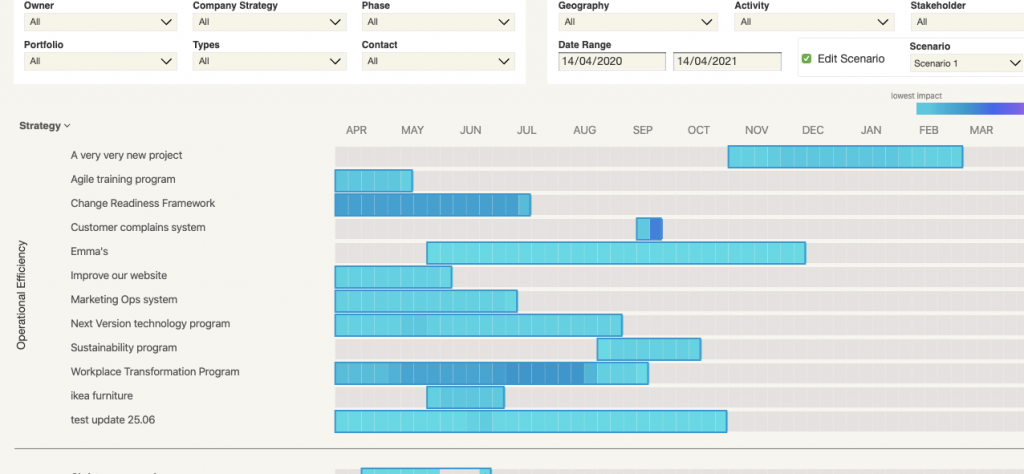
Long term – Build change capacity and resilience
1. Hire more people. For some parts of the organisation where there the change saturation is on frontline consultants servicing the customer. It may be possible to increase change capacity to some extent by hiring more staff to serve the customer. However, this depends how effective the organization is in quickly hire and onboard frontline consultants to reach ‘time to performance’. For other parts of the organisation where the subject matter experts may be in short demand because of COVID19, leveraging potential business substitutes where available may be an option. This approach may be used in conjunction with other recommendations to reduce change saturation.
2. Improve the change capability of leaders. One of the most important levers in building change capacity and resilience is the effectiveness of leaders. We have all seen how some leaders who are engaging, open, actively make way for the change, and address any obstacles, have led teams to undergo significant change journeys. Other leaders may be undergoing the same change journey but somehow have not had the same success. Instead, they could be plagued with change resistance and stagnation due to the ability of its leader. Change leadership development of leaders is a long term play and not a quick win by any means.
3. Work on change maturity. Organisations that have higher change maturity have more capacity for change and are more resilient to constant changes. Change maturity measures such as change leadership capability, business change readiness and project change implementation maturity. This is also a long term play, requiring significant focus and time investment.
Here are some articles you may be interested
A guide to planning during COVID19 the role of change practitioners
A new guide for improving change management maturity




